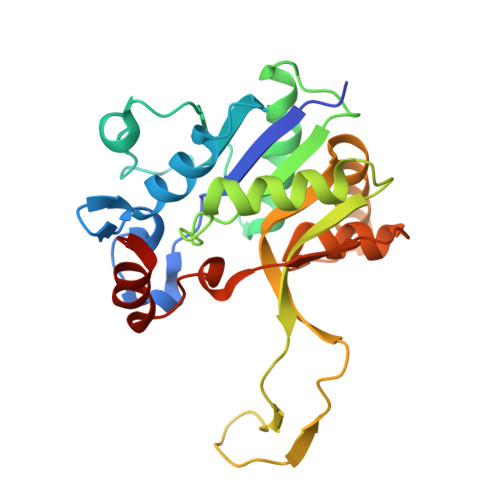Crystal structure and biophysical characterization of IspD from Burkholderia thailandensis and Mycobacterium paratuberculosis.
Pierce, P.G., Hartnett, B.E., Laughlin, T.M., Blain, J.M., Mayclin, S.J., Bolejack, M.J., Myers, J.B., Higgins, T.W., Dranow, D.M., Sullivan, A., Lorimer, D.D., Edwards, T.E., Hagen, T.J., Horn, J.R., Myler, P.J.(2024) Acta Crystallogr F Struct Biol Commun 80: 43-51
- PubMed: 38305785
- DOI: https://doi.org/10.1107/S2053230X24000621
- Primary Citation of Related Structures:
4ZDQ - PubMed Abstract:
The methylerythritol phosphate (MEP) pathway is a metabolic pathway that produces the isoprenoids isopentyl pyrophosphate and dimethylallyl pyrophosphate. Notably, the MEP pathway is present in bacteria and not in mammals, which makes the enzymes of the MEP pathway attractive targets for discovering new anti-infective agents due to the reduced chances of off-target interactions leading to side effects. There are seven enzymes in the MEP pathway, the third of which is IspD. Two crystal structures of Burkholderia thailandensis IspD (BtIspD) were determined: an apo structure and that of a complex with cytidine triphosphate (CTP). Comparison of the CTP-bound BtIspD structure with the apo structure revealed that CTP binding stabilizes the loop composed of residues 13-19. The apo structure of Mycobacterium paratuberculosis IspD (MpIspD) is also reported. The melting temperatures of MpIspD and BtIspD were evaluated by circular dichroism. The moderate T m values suggest that a thermal shift assay may be feasible for future inhibitor screening. Finally, the binding affinity of CTP for BtIspD was evaluated by isothermal titration calorimetry. These structural and biophysical data will aid in the discovery of IspD inhibitors.
- Seattle Structural Genomics Center for Infectious Disease (SSGCID), Seattle, WA 98109, USA.
Organizational Affiliation:





















